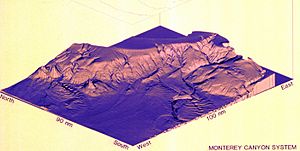Monterey Canyon facts for kids
The Monterey Canyon, also known as the Monterey Submarine Canyon, is a giant underwater canyon located in Monterey Bay, California. Imagine a canyon on land, but deep under the ocean! Its walls are incredibly steep, dropping about a mile from top to bottom. That's almost as deep as the famous Grand Canyon!
This amazing underwater feature is the largest of its kind along the West Coast of North America. It was formed over millions of years by powerful underwater currents called turbidity currents. These currents are like underwater rivers of mud and sand that carve out the seafloor.
Scientists are still working to understand exactly how the Monterey Canyon formed. Because of its unique features, it's a perfect place for studying geology and marine life. Researchers from places like the Monterey Bay Aquarium Research Institute and the Moss Landing Marine Laboratories are constantly exploring its depths.
The Monterey Canyon starts near Moss Landing, California, right in the middle of Monterey Bay. From there, it stretches out about 95 mi (153 km) under the Pacific Ocean. At its deepest point, called the Monterey Canyon submarine fan, it reaches depths of up to 3,600 meters (11,800 feet) below the surface!
The Monterey Canyon is part of a larger system that includes other underwater canyons like Soquel and Carmel Canyons. Its great depth and the constant flow of nutrient-rich sediment make it a perfect home for many different kinds of marine animals and plants.
A special area called the Soquel Canyon State Marine Conservation Area helps protect a part of the Monterey Submarine Canyon. This area acts like an underwater park, helping to keep the ocean wildlife and their homes safe.
How the Monterey Canyon Formed
Scientists know that the Monterey Submarine Canyon was carved out by strong underwater currents called turbidity currents. However, they are still trying to figure out why this canyon is so incredibly deep and long. They also wonder why there's such a huge pile of sediment, called a "fan," at its end, about 95 miles west of Monterey.
Usually, underwater canyons this big are formed by very large rivers, like the Mississippi or the Amazon. These rivers would have flowed into the ocean and carried huge amounts of sediment, carving out deep paths. The Salinas River, which flows into Monterey Bay today, isn't big enough to have created such a massive canyon.
Ancient River Theories
One popular idea is that the Monterey Canyon is what's left of an ancient path for the Colorado River. This would have been before the Gulf of California opened up about 7.9 million years ago. Another idea suggests it might have been the outlet for an even larger river that once drained California's Central Valley.
The Salinas River is thought to have been the outlet for a prehistoric lake called Lake Corcoran. This lake once covered much of the Central Valley. Scientists believe that when Lake Corcoran found a new way to drain, possibly through what is now San Francisco Bay, a huge amount of sediment was carried down to Monterey Bay. This event might have helped form the upper layers of the Monterey submarine fan.
Moving Land and Clues
Scientists use plate tectonic theory to understand how the Earth's land has moved over millions of years. These theories suggest that the Monterey Canyon has slowly moved north to its current spot. This movement happened because of the sliding action of the San Andreas Fault. Long ago, the canyon might have been located where Santa Barbara is today.
Similar underwater canyons exist at the mouths of other large rivers around the world, like the Hudson River Canyon. Since no major river flows into the head of Monterey Canyon today, it's believed that a much larger river must have been there in the past.
The biggest clues about the canyon's ancient past are found at its deepest point, about 2 miles down, in the huge sediment bed called the Monterey Fan. This fan seems far too big to have been created by the small coastal streams we see today. Scientists are taking core samples from this fan, which are like long tubes of mud and rock. By studying these samples, they hope to find older layers of sediment. Once they analyze these deeper samples, they might finally discover which ancient river was powerful enough to carve out this incredible canyon and create such a massive sediment fan.


